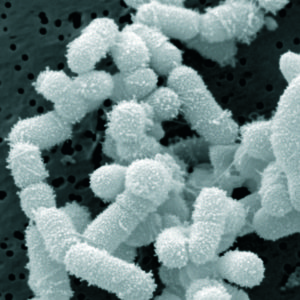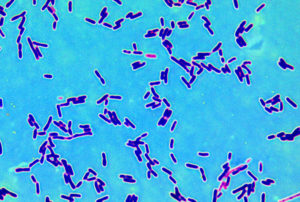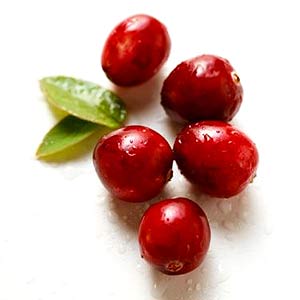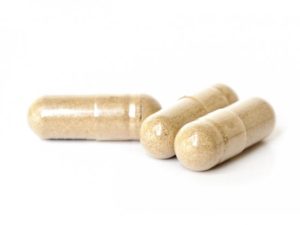 An interesting study that compared bacterial communities between healthy children and those that have a history of acute sinusitis (but not chronic sinusitis). The study specifically looked at the nasopharyngeal (NP) microbiome (community of microbes) over the course of one year in the 2 groups of children, who were between the ages of 4 and 7. Nasopharyngeal pertains to the nose or nasal cavity and pharynx. They used modern methods of genetic analysis to test for bacterial species - and found a total of 951 species among the 47 children, of which 308 species had some "depletion" among those children with a history of sinusitis, and one species was increased in "abundance".
An interesting study that compared bacterial communities between healthy children and those that have a history of acute sinusitis (but not chronic sinusitis). The study specifically looked at the nasopharyngeal (NP) microbiome (community of microbes) over the course of one year in the 2 groups of children, who were between the ages of 4 and 7. Nasopharyngeal pertains to the nose or nasal cavity and pharynx. They used modern methods of genetic analysis to test for bacterial species - and found a total of 951 species among the 47 children, of which 308 species had some "depletion" among those children with a history of sinusitis, and one species was increased in "abundance".
NP samples from children with a prior history of acute sinusitis were characterized by significant depletion of bacterial species, including those in the Akkermansia, Faecalibacterium prausnitzii, Clostridium, Lactobacillus, Prevotella, and Streptococcus species. But there was a siignificant increase "in relative abundance" in the bacterial species Moraxella nonliquefaciens. Once again, a study shows bacterial communities to be "out of whack" in those who've had sinusitis - this time in children. And the diminished diversity was linked to more frequent upper respiratory illnesses. The researchers mention the "possibility that the manipulation of the airway microbiota" could help prevent childhood respiratory diseases. Research by C.A. Santee et al from the Microbiome journal at BioMed Central:
Upper respiratory infections (URI) and their complications are a major healthcare burden for pediatric populations. Although the microbiology of the nasopharynx is an important determinant of the complications of URI, little is known of the nasopharyngeal (NP) microbiota of children, the factors that affect its composition, and its precise relationship with URI.
Healthy children (n = 47) aged 49–84 months from a prospective cohort study based in Wisconsin, USA, were examined. Demographic and clinical data and NP swab samples were obtained from participants upon entry to the study. All NP samples were profiled for bacterial microbiota using a phylogenetic microarray, and these data were related to demographic characteristics and upper respiratory health outcomes. The composition of the NP bacterial community of children was significantly related prior to the history of acute sinusitis. History of acute sinusitis was associated with significant depletion in relative abundance of taxa including Faecalibacterium prausnitzii and Akkermansia spp. and enrichment of Moraxella nonliquefaciens. Enrichment of M. nonliquefaciens was also a characteristic of baseline NP samples of children who subsequently developed acute sinusitis over the 1-year study period. Time to develop URI was significantly positively correlated with NP diversity, and children who experienced more frequent URIs exhibited significantly diminished NP microbiota diversity (P ≤ 0.05).
These preliminary data suggest that previous history of acute sinusitis influences the composition of the NP microbiota, characterized by a depletion in relative abundance of specific taxa. Diminished diversity was associated with more frequent URIs.
....These observations indicate that the composition of the pediatric upper airway represents a critical factor that may either potentiate or protect against infection by respiratory pathogens. They also indicate that the interplay between the bacterial microbiota and respiratory pathogens associated with upper airway infection is important to consider.Both bacteria and viruses can influence each other’s pathogenicity [8] and a number of interactions between specific viruses and bacterial species have been reported in the airways [9, 10]. For example, human rhinovirus infection was found to significantly increase the binding of Staphylococcus aureus, S. pneumoniae, or H. influenzae to primary human nasal epithelial cells [11]....
A total of 951 taxa were identified in baseline NP microbiota of participants (n = 47) in our cohort. These bacterial communities were variably composed of members of the Rickenellaceae, Lachnospiraceae, Verrucomicrobiaceae, Pseudomonadaceae, and Moraxellaceae as well as multiple unclassified members of the phylum Proteobacteria. .... Our study used independent NP samples collected from individual participants over a 12-month study period that spanned all four seasons. Season of sample collection also demonstrated a relationship with bacterial beta-diversity.
Compared with children who had no history of acute sinusitis (n = 33), those with a past history of acute sinusitis (n = 14) did not exhibit differences in α-diversity indices, suggesting that differences in microbiota characterizing these groups may be due to the enrichment or depletion of a subset of taxa within these bacterial communities. A total of 309 taxa (representing 101 genera) exhibited significant differences in relative abundance between children with and without a history of acute sinusitis. NP samples from children with a prior history of acute sinusitis were characterized by significant depletion of 308 of the 309 taxa, including those represented by Akkermansia, Faecalibacterium prausnitzii, Clostridium, Lactobacillus, Prevotella, and Streptococcus species. The only taxon that exhibited a significant increase in relative abundance in these subjects was represented by Moraxella nonliquefaciens.
Children who experienced at least one URI (n = 17) within 60 days of collection of the baseline sample had significantly lower phylogenetic diversity compared to those who had no URIs within that time frame (n = 23). Time to development of URI, defined as the number of days between the collection of the baseline sample and the first incidence of URI (a value of 365 days was assigned to those children who did not experience a URI during the year of monitoring), was also significantly correlated with phylogenetic diversity .... Hence, these data indicate that diminished diversity of the NP microbiota is a precursor to URI in these children.
In addition to Moraxella, a Corynebacterium was enriched in relative abundance in the NP microbiota of children who experienced acute sinusitis subsequent to baseline sample collection during the study period. ... However, Abreu et al. previously found Corynebacterium tuberculostearicum to be significantly enriched in the maxillary sinuses of adults with chronic rhinosinusitis compared to healthy control subjects [17]. The authors subsequently confirmed the ability of C. tuberculostearicum to induce acute sinusitis in the context of an antimicrobial-depleted murine model of sinus infection. Moreover co-installation of Lactobacillus sakei (one of a number of taxa acutely depleted in relative abundance among chronic rhinosinusitis patients) protected animals against C. tuberculostearicum infection [17]. Our pediatric data exhibits similarity with these murine studies, in that six members of the Lactobacillus genus were among those taxa most significantly depleted in relative abundance in the NP bacterial communities of children who developed sinusitis during our study. Five of these same taxa were also depleted in relative abundance in the NP microbial communities of children with a prior history of sinusitis.
In addition to Lactobacillus, many other bacterial taxa including Akkermansia, Faecalibacterium prausnitzii, Clostridium, Prevotella, and Streptococcus species were depleted in relative abundance among children with a prior history of acute sinusitis. Though traditionally associated with gut microbiota, anaerobic bacterial species can exist in biofilms in the upper respiratory tract [18] and Akkermansia and Faecalibacterium have previously been detected in the nasopharynx of children [19, 20]. While its role in the airway is unknown, gastrointestinal Akkermansia muciniphilia metabolizes mucin and has been shown to activate immune homeostasis, increasing host expression of antimicrobial peptides such as RegIIIγand improving barrier function via an increase in 2-oleoylgylcercerol [21, 22, 23]. However, whether such mechanisms play a role at the airway mucosal surface remains to be determined.
Mechanisms by which Lactobacillus and other bacterial species depleted in the NP microbiota of sinusitis patients may prevent the development of disease include competitive exclusion of pathogenic species. A previous murine study indicated that intra-nasal inoculation of mice with L. fermentum decreased S. pneumoniae burden throughout the respiratory tract and increased the number of activated macrophages in the lung and lymphocytes in the tracheal lamina propria [24]. Hence, it is plausible that the absence of NP genera with known competitive exclusion and immunomodulatory capabilities leads to pathogen expansion and associated clinical manifestations of upper airway infection.
....We do show that a history of sinusitis, its pathophysiology or treatment, may shape the NP microbiota—which may inform future studies and their design. Additionally, though we recognize that the composition of the microbiota in the upper airways is likely highly influenced by antibiotic administration .... The pervasive effects of antimicrobials on the human microbiota are well-described [26, 27], and it is likely that lifetime antibiotic use plays an important role in shaping the baseline NP microbial community.
The composition of the NP microbiota in healthy children between 49 and 84 months of age is associated with past and subsequent history of acute sinusitis and frequency of URI. Widespread bacterial taxon depletion and enrichment of M. liquefaciens and C. tuberculostearicum are associated with upper airway infection and the development of acute sinusitis. Collectively, these findings provide evidence of close connections between microbial colonization of the airways and susceptibility to upper respiratory illnesses in early childhood and raise the possibility that the manipulation of the airway microbiota could be applied to the prevention of childhood respiratory illnesses.

 Lactobacillus sakei
Lactobacillus sakei  Amazing! Researchers found that the bacteria found in breast cancer patients and healthy patients are different. (
Amazing! Researchers found that the bacteria found in breast cancer patients and healthy patients are different. ( A study found that a combination of cranberry supplement (120 mg cranberries, with a minimum proanthocyanidin content of 32mg), the probiotic Lactobacillus rhamnosus, and vitamin C (750 mg) three times a day was enough to prevent the recurrence of urinary tract infections (UTIs) for the majority of women in this small (36 patient) study. At 6 months there was a 61% success rate. No side effects were reported.
A study found that a combination of cranberry supplement (120 mg cranberries, with a minimum proanthocyanidin content of 32mg), the probiotic Lactobacillus rhamnosus, and vitamin C (750 mg) three times a day was enough to prevent the recurrence of urinary tract infections (UTIs) for the majority of women in this small (36 patient) study. At 6 months there was a 61% success rate. No side effects were reported. Many probiotic manufacturers say that their product has all sorts of wonderful health benefits in people eating that particular probiotic, but is the evidence there? Finally, now there is a
Many probiotic manufacturers say that their product has all sorts of wonderful health benefits in people eating that particular probiotic, but is the evidence there? Finally, now there is a  The possibility of giving microbes in the future (whether bacteria, viruses, or fungi) to treat cancer is amazing. Of course big pharma is pursuing this line of research, which is called immunotherapy (stimulating the body's ability to fight tumors). The Bloomberg Business article discusses a number of big pharma companies entering the field and their main focus. The study in the journal Science finding that giving common beneficial bacteria (Bifidobacterium breve and Bifidobacterium longum) to mice to slow down melanoma tumor growth is a first step. The researchers themselves said that the 2 common beneficial bacteria species exhibited anti-tumor activity in the mice and was as effective as an immunotherapy in controlling the growth of skin cancer. But note that the bacteria needed to be live. Stay tuned....
The possibility of giving microbes in the future (whether bacteria, viruses, or fungi) to treat cancer is amazing. Of course big pharma is pursuing this line of research, which is called immunotherapy (stimulating the body's ability to fight tumors). The Bloomberg Business article discusses a number of big pharma companies entering the field and their main focus. The study in the journal Science finding that giving common beneficial bacteria (Bifidobacterium breve and Bifidobacterium longum) to mice to slow down melanoma tumor growth is a first step. The researchers themselves said that the 2 common beneficial bacteria species exhibited anti-tumor activity in the mice and was as effective as an immunotherapy in controlling the growth of skin cancer. But note that the bacteria needed to be live. Stay tuned.... A thought-provoking
A thought-provoking  Very exciting research IF it pans out - the idea of treating (some) cancers with probiotics (beneficial bacteria). This study was done on mice, and some mice started the probiotic mixture one week before they gave the mice the liver cancer, so...more limitations there. But the idea is so tantalizing and wonderful... And what was in the mixture of bacteria (called probiotic Prohep) that the mice ate that had beneficial results of shrinking liver tumors? The probiotic Prohep is composed of Lactobacillus rhamnosus GG (LGG), Escherichia coli Nissle 1917 (EcN), and heat inactivated VSL#3 (1:1:1). VSL#3 contains: Streptococcus thermophilus, Bifidobacterium breve, Bifidobacterium longum, Bifidobacterium infantis, Lactobacillus acidophilus, Lactobacillus plantarum, Lactobacillus paracasei, and Lactobacillus delbrueckii. Note that Lactobacillus rhamnosus and some of the others are already found in many probiotic mixtures. From Medical Xpress:
Very exciting research IF it pans out - the idea of treating (some) cancers with probiotics (beneficial bacteria). This study was done on mice, and some mice started the probiotic mixture one week before they gave the mice the liver cancer, so...more limitations there. But the idea is so tantalizing and wonderful... And what was in the mixture of bacteria (called probiotic Prohep) that the mice ate that had beneficial results of shrinking liver tumors? The probiotic Prohep is composed of Lactobacillus rhamnosus GG (LGG), Escherichia coli Nissle 1917 (EcN), and heat inactivated VSL#3 (1:1:1). VSL#3 contains: Streptococcus thermophilus, Bifidobacterium breve, Bifidobacterium longum, Bifidobacterium infantis, Lactobacillus acidophilus, Lactobacillus plantarum, Lactobacillus paracasei, and Lactobacillus delbrueckii. Note that Lactobacillus rhamnosus and some of the others are already found in many probiotic mixtures. From Medical Xpress: Could the bacteria described in this research be another probiotic or beneficial bacteria (besides Lactobacillus sakei) that helps protect against sinusitis? New research found that the harmless bacteria Corynebacterium accolens is "overrepresented" in children free of Streptococcus pneumoniae (pneumococcus) - which commonly colonizes in children's noses (and that can live harmlessly as part of a healthy microbiome), but it is also an important infectious agent. Streptococcus pneumoniae is a major cause of pneumonia, septicemia, meningitis, otitis media (ear infections), and sinusitis in children and adults worldwide.
Could the bacteria described in this research be another probiotic or beneficial bacteria (besides Lactobacillus sakei) that helps protect against sinusitis? New research found that the harmless bacteria Corynebacterium accolens is "overrepresented" in children free of Streptococcus pneumoniae (pneumococcus) - which commonly colonizes in children's noses (and that can live harmlessly as part of a healthy microbiome), but it is also an important infectious agent. Streptococcus pneumoniae is a major cause of pneumonia, septicemia, meningitis, otitis media (ear infections), and sinusitis in children and adults worldwide.